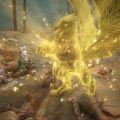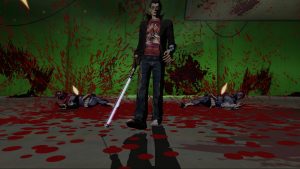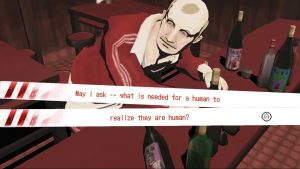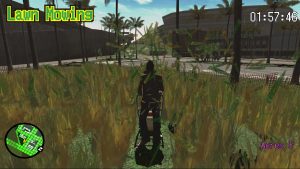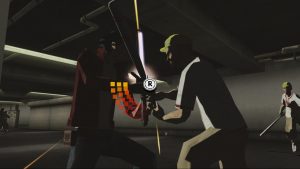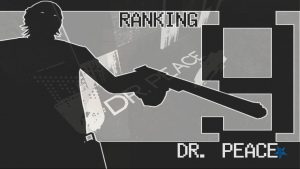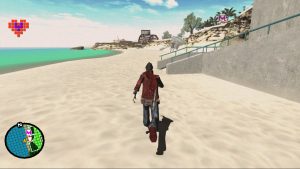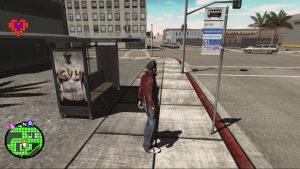Goichi “SUDA 51” Suda has gotten a lot of mainstream attention in the past two decades. He’s become one of those weird Japanese developers that embody artistry over mechanical satisfaction, both to amazing ends and frustrating lows. It’s difficult to ignore the guy, nor not have some respect for him, even if you don’t really like what he’s trying to make.
Killer is Dead was hit with harsh criticism for its portrayal of women, Lollipop Chainsaw was hotly debated in the same manner as Bayonetta for how it portrayed its sexually charged heroine, and the western game press just had absolutely no idea how to view Killer7 upon its release. He’s a polarizing figure (who also played a masked wrestler in Yakuza 2) who makes public appearances dressed up as a masked wrestler.

The man first started working as a grave keeper and became interested in video games, getting a job writing for the Super Fire Pro Wrestling games and writing that infamous twist in Special where the main character killed himself at the end after losing a battle with depression. This was 1994. The guy was as ahead of the curve as fellow experimenters Hideo Kojima (Metal Gear, Snatcher) and Kenji Eno (D series and Real Sound: Kaze no Regret, a game made for the blind).
Around 1998, Suda made his own studio titled Grasshopper Manufacture, and it wasn’t long before they started producing a series of bizarre mystery games (the only one the west got until recently being the incredibly meta Flower, Sun and Rain via a DS port, though the full Silver Case series is now properly released). 2005’s Killer7, a joint production with Capcom, got their name out in the west, but what gave them footing was a Wii game titled No More Heroes.

NMH came out on the right system at just the right time to get some significant attention. The Nintendo Wii was suffering among more mature markets for not having a strong library of M-rated titles, and titles like MadWorld were still a year or two away. They needed something that could make a splash, and if you want an attention grabbing splash, getting a game released by a former undertaker who wrote a wrestler’s suicidal spiral into depression is a good way to do it.
NMH became a household name for awhile, with its sequel even gathering a surprising amount of attention and buzz, and it’s not hard to see why. No More Heroes was far more approachable than the obtuse Killer7, but was still bizarre enough that you couldn’t really forget it. Killer7 drowned itself in the works of cinematic rebels, while No More Heroes took its influences from punk, anime, and urban trends, and it added a dash of criticism to the mix that a lot of players failed to notice, but was extremely obvious and blunt in retrospect.

The title cast you as Travis Touchdown, a wannabe assassin living at the No More Heroes hotel in Santa Destroy, California. You’ve been dared by a woman named Sylvia Christel to climb the UAA (United Assassin’s Association) rankings and become the number one assassin. Travis gets to sleep with her if he does it. Did I mention that Travis is a virgin otaku who fights with a beam katana he bought in an eBay auction, has an apartment littered with anime figures and magical girl posters he presents to the audience while whispering “MOE”? Travis Touchdown is kind of …eccentric. The goal is to fight in ranked matches, ten to one, as it becomes clearer and clearer that the game is messing with you.
No More Heroes didn’t really set the world on fire because of its mechanics, partly because Suda was trying to make something with simple gameplay. It’s a hack ‘n slash with a beam sword you have to recharge via shaking every few swings (which, of course, looks like masturbating), using a limited move set to build up to dark side mode, where you can pull off visually stunning finishing moves in a random super mode.

One has you going Super Sayian and chopping up dudes instantly. Another turns everything into a scene from a lost Tarantino flick as you move slowly as the world goes black and white, utterly decimating whatever crawling goon you lock onto. They’re cool to look at, but most combat gets tedious as you have to play a ton of extra missions over and over for cash needed for upgrades. The open world elements also didn’t help, as the city of Santa Destroy is devoid of life and much of anything to do, like it’s just there to be a joke about the pointlessness of open worlds that stops being funny the longer you have to drive around it.
The game feels like work most of the time (which might be intentional), up until you reach the next combat section. But the real rewards are the boss battles. Travis has to fight ten different assassins, and they’re all wildly different with their own skills, techniques, and a different target of parody or homage. The tenth ranking assassin, Death Metal, has a David Bowie/Ozzy Osborn thing going on, Shinobu is a gender bent Afro Samurai, Destroyman is a mix between tokusatsu superhero and mailman serial killer who had one bad day too many, and Bad Girl…there’s a lot to say about her. Coming in at number two, she’s like every self-destructive western pop princess taken to incredible extremes, as she chugs beers and casually wallops masochists in bondage gear with her bat for fun. There’s so many more to see, a personal favorite being Dr. Peace, a singing detective cowboy assassin. Just read that description.

Every one of these boss battles is instantly engaging. The short cutscenes with these bosses tells you so much about who they are and why they do the things they do, and you just feel like you have to live up to their standards or take them out. They also all have their own mechanical tricks, like a magician who changes the entire perspective of a fight, or an old homeless woman who constantly fires a massive beam cannon at you from a distance in the ruins of the slums.
Every single battle is memorable, as I can name some of the best moments in each fight these many years later without touching the game to check. Crawling out of Holly’s pitfalls, cutting Destroyman in half after he tries to get you with a last minute trick, avoiding Shinobu’s big special attack, or trying to close in on Dr. Peace without wearing out your beam charge blocking his bullets. Every single one of these fights got painted into the memory of thousands of fans, and that is a testament to the near perfect design and length. The two final boss fights stick out in particular for how normal yet brutal they are, a real test of your skill.

These fights didn’t capture attention solely because of mechanics or challenge, though, but rather personality. The entire game is oozing with quotable lines (“If challenge had a taste, you’d be quite delicious” and “I want to gorge myself on this sense of fulfillment till I vomit” being highlights) from cheesy but talented actors. Everyone gets genre defined outfits with a cel shaded look given a grunge feel. There’s a fantastic experimental score that mashes all sorts of styles and sounds together, with Stop Hanging DJs and Pleather for Breakfast as two of the most memorable pieces.
The graphical style changes when you enter dark side mode, everything is covered in thick, almost suffocating shadows that make the world feel truly threatening, a familiar element to a lot of early Grasshopper titles (including Killer7). The world feels both real and alien, like you’re in the underbelly of reality and everything is slowly coming apart at the seems.

With the more conventional story and mechanics, this style became much easier to swallow for western audiences, with no other game, even from Grasshopper, managing to capture the style of the NMH series. It even has stylized expressions, making use of their limitations to build a mood and more memorable character designs. Ugly is an important part of horror, and while this title isn’t horror, it takes that to heart and gives itself a look that wouldn’t look out of place in a horror game at points. Just look at Destroyman’s introduction scene.
The game is good, but it also shares the same qualities as other great Grasshopper games before it; thematic depth. Suda formerly working at a graveyard may have had a hand in how he writes his narratives, as he has a bit of an obsession with violent media. No More Heroes is his masterwork when it comes to exploring that, creating a story where you, the player, are going deeper and deeper into this ridiculous video game story about a lunatic killing other lunatics for fun and sex as it starts to become quieter, darker, and more unsettling. Basically, do you feel like a hero yet five years before Spec Ops: The Line.

Familiar faces disappear, bosses give you moral lectures, and eventually even violence changes from being portrayed as awesome to disturbing, really highlighted when you defeat Bad Girl. It never gets too preachy over this, and it ends on an absolutely brilliant comedic turn that flips everything around by having you face a character you wanted to see yourself as.
Travis is meant to represent what the average player to the staff is like, and the true final boss is what we want to feel like when we play these games. Well, you have to earn that right in the end in one of the most satisfying sword on sword battles in gaming history against a being that stands as an example of perfection in practically every way. Even by the very end, has anything been accomplished? Is there really an exit to paradise, or can we only keep running in circles to find it?

The game received high marks all across the board, though sales were less than stellar in its homeland. In the west, however, it was a modest success, and surpassed all expectations in Europe. SUDA 51 finally had his hit, and it challenged a lot of conventions in gaming culture. How we interpret violent media, how we see our heroes and villains, what we consider good and evil, and most importantly, the idea that mechanics had to be key to a game’s success.
It was the big talk about this being the mature title the Wii craved, and it eventually got ports to the PS3 and X360, though only the PS3 version was released internationally. Unfortunately something was really missing from these. The Wii remote was often criticized for adding useless gimmicks, but it really did add to the combat here, and changing the sword slashes from physical motions to analog stick clicks just doesn’t feel right. It does run in HD, but the framerate is much, much worse. There are a few confusing differences between the Japanese release, initially dubbed Heroes’ Paradise. The Xbox 360 version has all of the gore but the PlayStation 3 is the same quasi-censored version as the Japanese Wii release, where coins pop out of killed enemies instead of blood. Both include Japanese voice acting too, missing from the original Wii release. A second version, Red Zone Edition, was released for the PlayStation 3, which also includes all of the gore plus extra missions and some extra boss fights from No More Heroes 2, as well as Move controller support. Red Zone Edition was used as the basis for the overseas No More Heroes: Heroes’ Paradise.
No More Heroes was later ported to Windows and the Switch, and while it’s missing some of this additional content from Heroes’ Paradise, and the Windows version launched in a pretty poor shape, they’re overall better than the previous HD release. All of the re-releases are missing Genki Robot’s “Heavenly Star” music track that was featured in the Wii release.
Ultimately No More Heroes doesn’t quite hit the same sweet-spot of insanity and convention shattering as Killer7, but it really blurred the line between a big budget blowout and a middle of the road experiment in a way nobody could have expected. To the surprise of everyone, even the developers (what with their cheeky true ending poking fun at this never getting a sequel), No More Heroes became a proper franchise…right when Suda began to take a back seat as a game developer.








